AI Video Editor Alternatives (Longform): TimeBolt vs Descript vs Gling vs Loom
Sep 17, 2025
=
Last Update: October 13, 2025
Accuracy is everything in long-form video
Podcasts, webinars, and YouTube uploads often run 30, 60, or even 120 minutes. At that scale small misses in silence or filler removal quickly compound into 10–15 minutes of content your audience doesn’t want to sit through, and you have to fix by hand.
In PART ONE of AI Video Editor Showdown we tested short-form accuracy (93 seconds) and showed why even a few seconds of filler can ruin watchability. In Part TWO we test a 60-minute Zoom recording and add Gling to the mix. In Part THREE we test CapCut vs Premiere Pro vs TimeBolt (Short and long form tests). In Part FOUR we test accuracy in removing bad takes between Descript vs Gling vs TimeBolt.
The verified results and files are presented below so others can reproduce the test.
For Context, Here are the Players:
-
Descript has raised around $100 million from investors that include OpenAI Startup Fund, Andreessen Horowitz, Redpoint, and Spark Capital.
-
Gling is a newer AI editor built for long-form creators, focusing on podcasts and YouTube videos with automated silence and filler removal.
-
Loom Acquired by Atlassian for $975 million in 2023.
-
TimeBolt is rapid video communications software, bootstrapped since 2019, no outside funding.
Summary of Findings
Each long-form test used the same 60-minute recording. Every file was processed with identical remove silence / filler automations.
-
TimeBolt finished cleanly at 42 min 55 sec. Removed 17 min 05 sec of waste with no re-review or manual correction.
-
Descript left 448 filler words and 171 seconds of silence, adding roughly 52 minutes of manual repair for a single hour-long video.
-
Gling performed similarly, cutting more aggressively but still missing over 600 filler words and introducing false cuts that require inspection.
-
CapCut required the most correction time. 3 hours of manual cleanup to repair timeline gaps / missed phrases.
-
Loom produced the longest output (57:47). No repair due to its lack of edit controls.
With Turbo enabled by default, TimeBolt sets the real-world benchmark at 38:09. Compared to this, Descript and Gling add back 20–25% more runtime. The equivalent of 10–15 minutes of extra filler in every hour of content.
What AI Missed
An unscripted 60-minute Zoom recording was run through each editor (TimeBolt, Descript, Gling, and Loom) using their default silence and filler-removal automations. Each exported file was then analyzed in TimeBolt to find leftover filler and quantify what isn't removed. Reverse-timeline shows only what each tool failed to cut. By running the JSON timeline data through TimeBolt, we could precisely measure how much unnecessary content each tool left.
-
Descript left 6 minutes 30 seconds of unnecessary content.
-
Gling (Bad Takes OFF) left 4 minutes 17 seconds of unnecessary content.
-
Loom left 15 minutes 30 seconds of unnecessary content.
-
TimeBolt had no waste file, because there was nothing left behind.
Descript Misses
Gling Misses
Loom Misses
*Data Verification: Each editor’s output was converted to JSON and re-evaluated in TimeBolt’s waveform timeline to ensure all silence and filler detections were measured accurately. Each tool’s JSON export was re-imported into TimeBolt’s reverse timeline to verify leftover waste time.
Accuracy and Re-Edit Overhead
In long-form editing, missed filler is not just a few minutes. When you compound accuracy across hours it’s the difference between watchable and unwatchable. Every missed silence or filler word compounds over hours of footage.
To measure post edit work we parsed a JSON output from each tool’s uncaught filler. Each miss represents a segment of silence longer than 0.3 seconds or a filler word that wasn’t cut. On average, each miss required 5–10 seconds of manual review and trimming.
This extra labor becomes real overhead:
In short: TimeBolt didn’t just finish faster. It finished clean.
Every silence and filler removed automatically meant zero wasted re-edits later. A result no AI-driven transcript editor matched in this test.
Methodology
Baseline Establishment (via Umcheck)
- Tool: TimeBolt Umcheck (v7.0.4)
- Settings: Silence detection at 0.5s, “Look for Repeats” enabled
This is Umcheck, TimeBolt's ala carte AI transcription service. The only software you can add any unique word tic or phrase.

Process
1. Add file with Silence Detection Settings
2. Run Umcheck
3. Click “Look for Repeats”
4. Click “Turn Off Selected Words”
5. Export JSON and SRT
Baseline Results
- Dead air (≥0.5s): 10:07
- Filler words: 605
- Repeated words: 343
- Total flagged words: 948
Software Versions
- TimeBolt: v7.0.4
- Descript: latest release (Sept 16, 2025)
- Gling: latest release (Sept 16, 2025)
Downloads:
- Raw 60-minute Zoom video (59:58 total duration)
- Raw 60-minute Zoom SRT transcript
Validation & Ground Truth — TimeBolt Removal Summary
[Verified] Using the TimeBolt Umcheck JSON exported from this exact 60-minute recording, we computed totals directly from timestamps (end − start) for every removed token/phrase. Per this dataset, TimeBolt’s pass removed the following:
| Metric | Value |
|---|---|
| Segments removed (filler + repeats) | 1,005 |
| Total time removed | 320.03 s (~5.33 min) |
| Immediate word-repeat events (adjacent) | 97 |
Top Tokens by Count
| Token | Count |
|---|---|
| yeah | 137 |
| uh | 101 |
| um | 76 |
| I | 63 |
| you | 63 |
| so | 55 |
| know | 54 |
| and | 36 |
| ok | 33 |
| the | 21 |
Top Tokens by Total Seconds Removed
| Token | Total Seconds |
|---|---|
| um | 43.96 |
| uh | 42.29 |
| yeah | 39.07 |
| so | 17.94 |
| I | 15.84 |
| and | 14.61 |
| ok | 11.45 |
| know | 10.89 |
| you | 8.38 |
| the | 8.34 |
Common Adjacent Phrases (Bigrams)
[Verified] Frequent adjacent patterns removed in this pass include: “you know” (53), “yeah yeah” (27), “uh uh” (23), “uh yeah” (20), “um yeah” (16), “yeah so” (16), “i mean” (12).
Two-Way Controls (Replicability)
- Negative control: Run the TimeBolt output through Descript and Gling. Expect 0 new filler/silence detections on this same clip.
- Positive control: Run the Descript/Gling outputs back through TimeBolt. Measure additional filler/silence TimeBolt still finds.
Artifacts for Audit
- Raw 60-minute video (MP4) — Download
- Source SRT transcript (Amazon Transcribe) — Download
- TimeBolt Umcheck JSON (this summary) — Download
- TimeBolt Output (MP4) + SRT — Download
- Descript Output (MP4/SRT) — Download
- Gling Output (MP4/SRT) — Download
Note: Filler list, matching rules (whole-word vs subword), minimum silence length (≥0.5s), padding, and version numbers are documented above so anyone can reproduce the counts.
TimeBolt Results
Settings
- Remove silence longer than 0.5s
- Ignore detections shorter than 0.75s
- Left padding 0.01s, right padding 0.15s
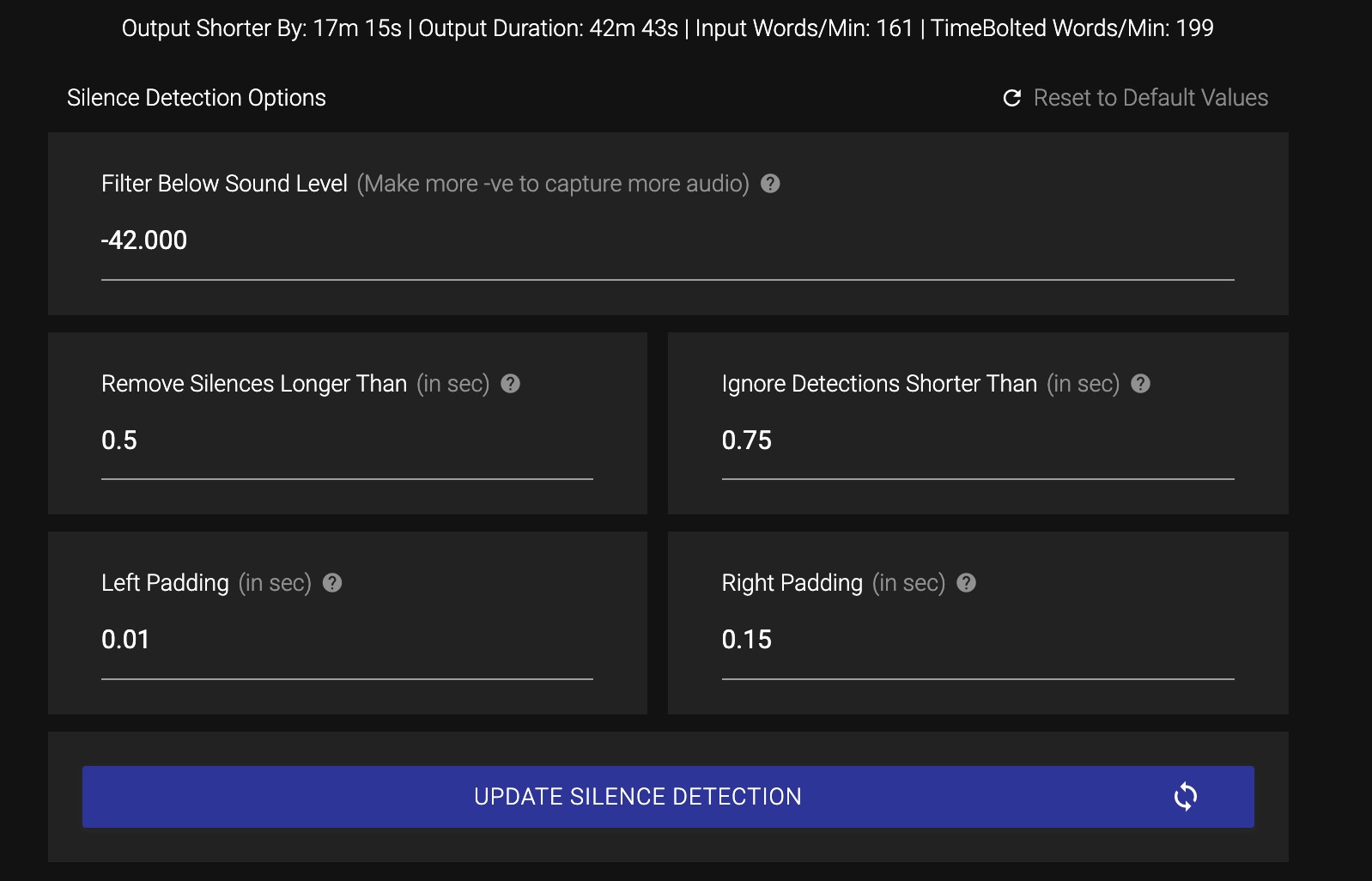
Performance
- Dead air removed: 10:07 (100%)
- Filler/repeats removed: 948 (100%)
- Final duration: 42:43
- Waste file: none
Bonus: With TurboMode (1.125x), final duration = 38:09
(With TurboMode increase your rate of speech and speak more words per minute without sounding like a chipmunk.)
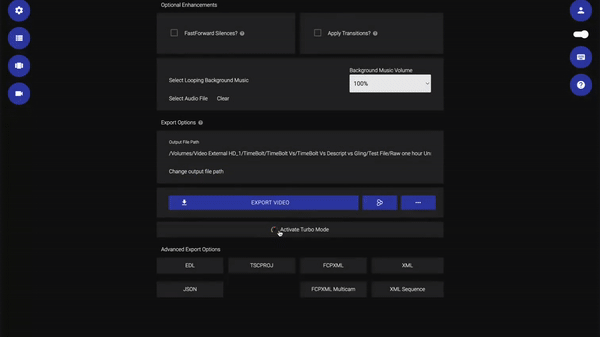
Downloads:
Download TimeBolt Output with Turbo
Descript Results
Settings
- Remove all filler words
- 'Avoid Harsh Cuts' turned off
- Remove gaps > 0.5s, shorten to 0.5s
Silence Detection
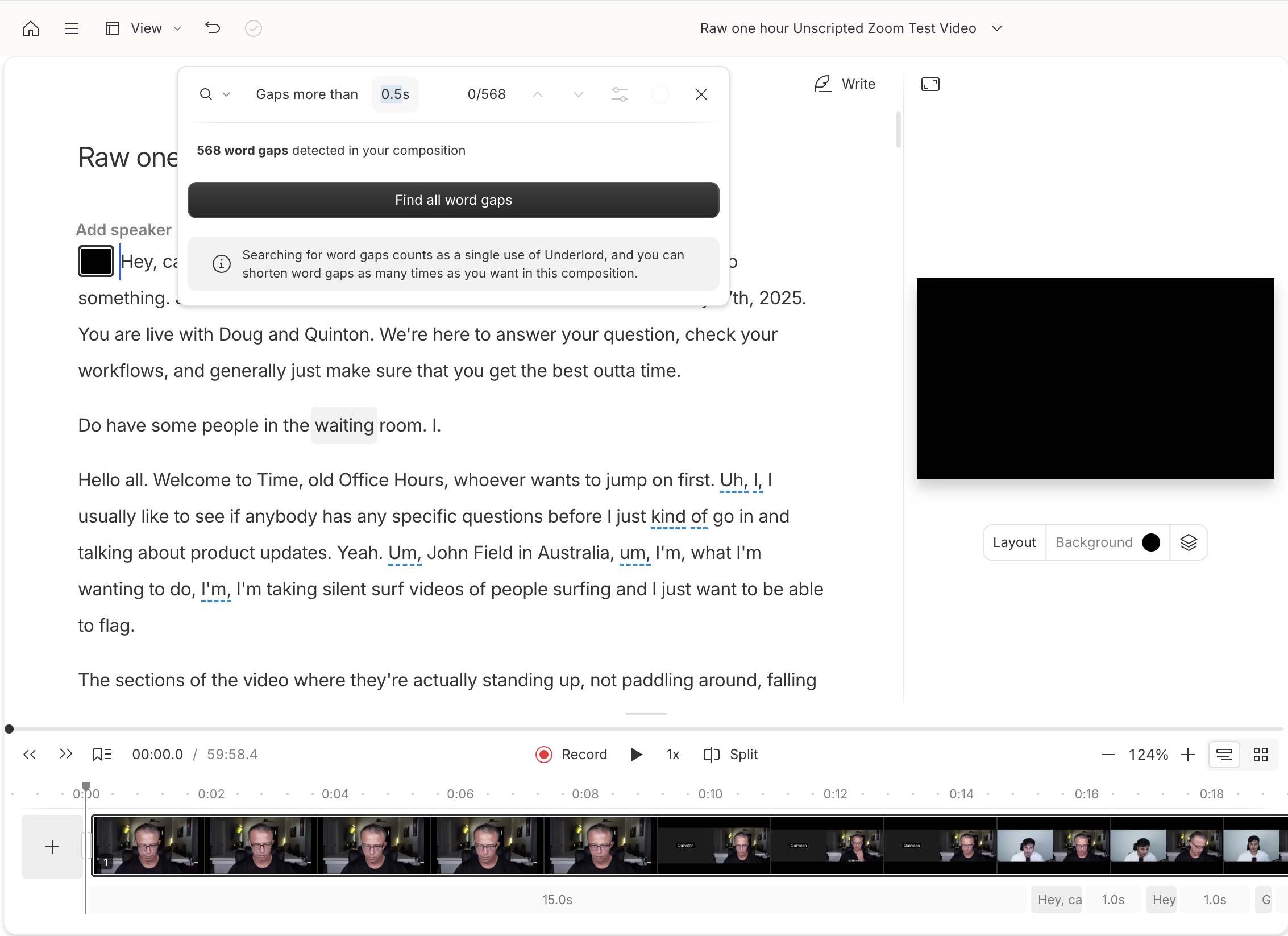
Filler Word Detection
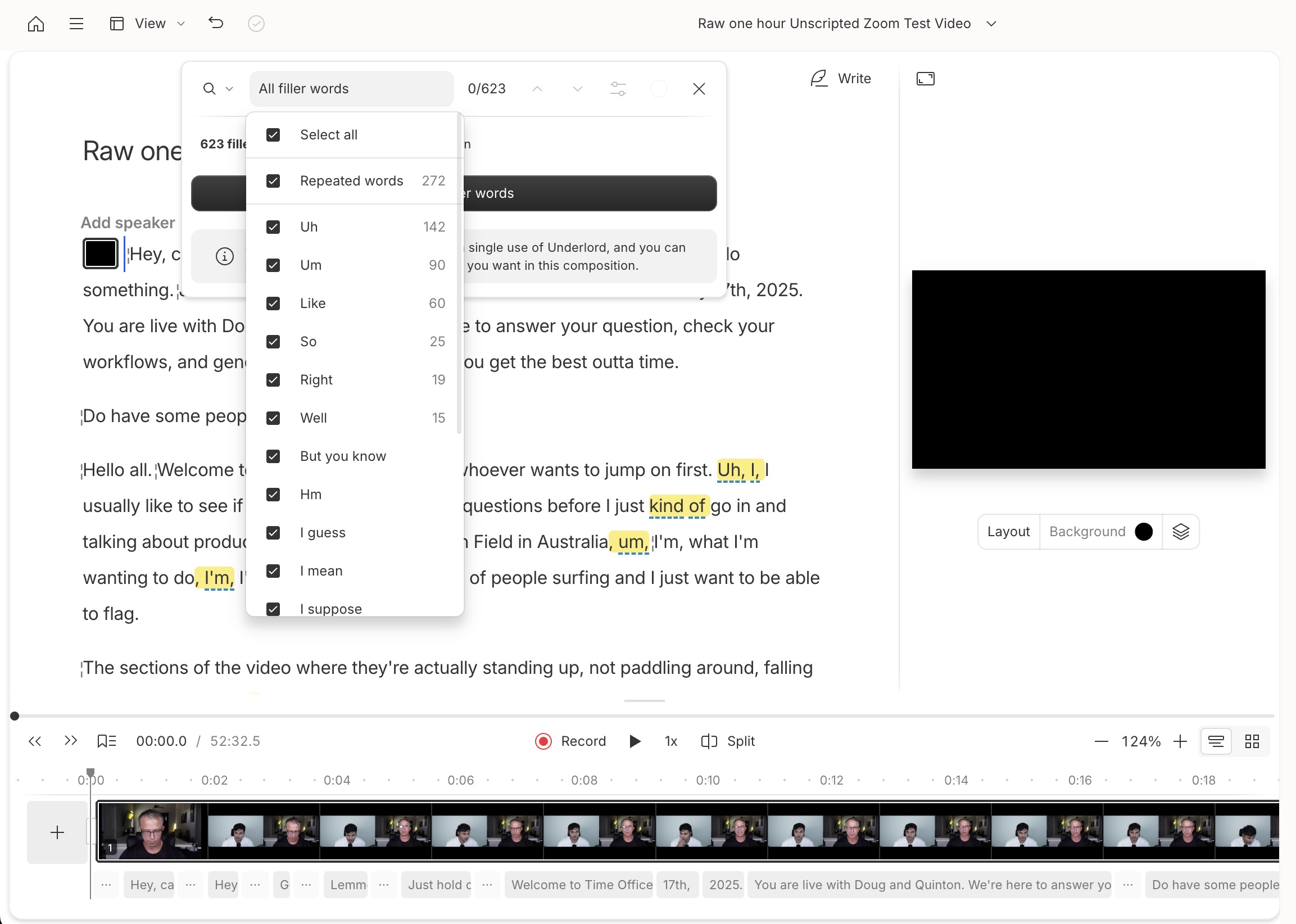
Performance
- Dead air removed: 7:26 (of 10:07 baseline, ~73%)
- Filler/repeats removed: 623 (of 948 baseline, ~66%)
- Final duration: 47:54
- Waste file: 6:30
Downloads:
Gling Results
Settings
- Silence detection at 0.5s
Gling Silence Detection

Dead air + filler only (Bad Takes disabled)
- Final duration: 46:18
- Waste file: 4:17
Interpretation
'Bad Takes' removal cut actual content, not just filler. For unscripted video, this risks losing meaningful material. Both with and without 'Bad Takes' turned on, Gling left 4+ minutes of filler and silence.
Downloads:
Loom Results
Settings
- No settings possible. Toggle on: Remove Silence / Remove Filler Words
Loom Silence Detection and Filler Removal
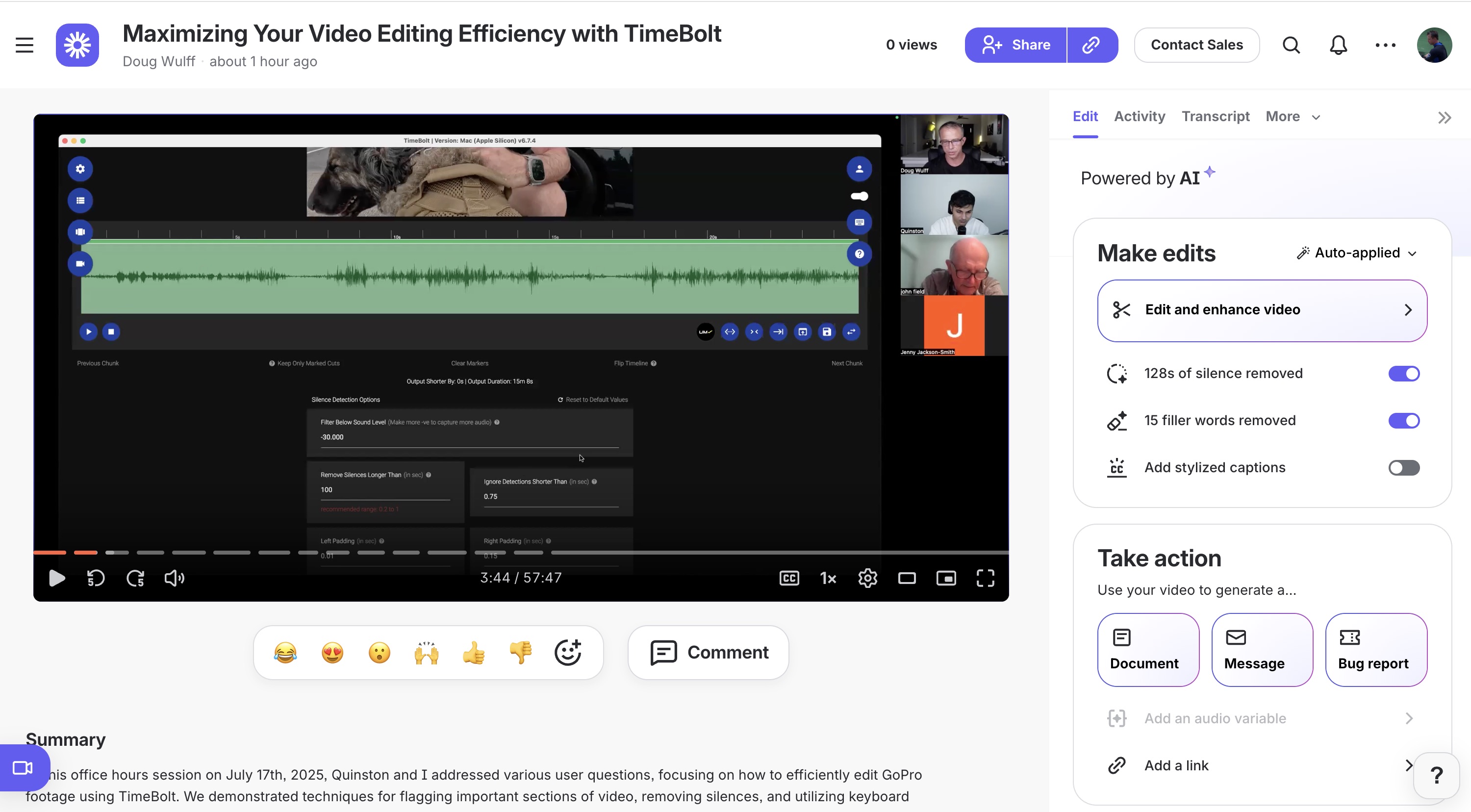
Dead air + filler
- Final duration: 57:47
- Waste file: 15:30
Downloads:
Reproducibility
All files used in this study are available for download. Anyone can repeat the test and verify the results.
Conclusion
-
TimeBolt’s waveform engine = 0 missed cuts = 0 cleanup.
-
Descript, Gling, CapCut depend on transcripts → they miss low volume speech & soft pauses.
-
Loom has no editing layer → cannot be fixed at all.
-
The difference between AI editing and actual automation is measured in hours of repair time.
For creators editing long recordings (podcasts, webinars, lectures, YouTube videos) those minutes matter.
Disclaimer: The results of this study are based on tests conducted and verified as of September 18, 2025. Software performance may change with future updates.
Update — October 2025:
Loom’s results were re-tested and verified using JSON data parsed through TimeBolt’s reverse-timeline analysis. The JSON confirmation ensures every missed silence and filler segment is accounted for, aligning this comparison with the same verification process used for Descript and Gling.

